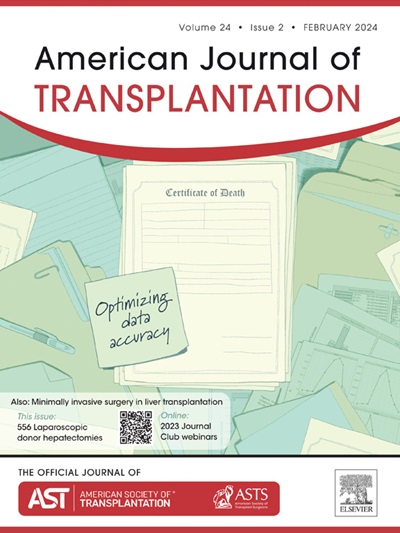Blunted cardiac reserve as a marker of cirrhotic cardiomyopathy—Cardiac outcomes following liver transplantation and comparison to the existing guidelines
IF 8.2
2区 医学
Q1 SURGERY
引用次数: 0
Abstract
Cirrhotic cardiomyopathy (CCM) is an underrecognized risk factor for cardiac events in patients undergoing liver transplantation (LT). Blunted cardiac reserve (BCR) is an emerging indicator of CCM, although it has not been integrated into diagnostic guidelines. This study assesses posttransplant cardiac outcomes and mortality in patients with BCR compared with current CCM diagnostic guidelines, focusing on diastolic indices. Consecutive patients undergoing liver transplant assessment were included. Of 978 patients screened with dobutamine stress echocardiography between 2010 and 2023, 481 (58.0%) progressed to LT, with 183 (38.0%) meeting BCR criteria and 117 (24.3%) meeting existing CCM diagnostic criteria. Thirty (6.2%) patients experienced a 30-day major adverse cardiovascular event (MACE), and 92 patients (19.1%) died on long-term follow-up. Following multivariate regression analysis, BCR was the strongest independent risk factor for postoperative MACE (hazards ratio [HR], 2.57; 95% CI, 1.13-5.85; P = .024), heart failure exacerbations (HR, 6.93; 95% CI, 1.46-33.01; P = .015), and 30-day mortality (HR, 9.69; 95% CI, 1.04-92.33; P = .049). Addition of BCR to the existing guidelines improved MACE prediction (HR, 5.81; 95% CI, 1.71-19.76; vs 2.59; 95% CI, 1.15-5.87; P = .006), with a net reclassification improvement index of 41.9% (P = .004) compared with existing guidelines alone. These results support the integration of a cardiac reserve assessment into CCM diagnostic criteria and use in risk stratification of patients undergoing LT.
钝性心脏储备作为肝硬化心肌病的标志-肝移植后的心脏结局及与现有指南的比较。
肝硬化心肌病(CCM)是肝移植(LT)患者心脏事件的一个未被充分认识的危险因素。钝心储备(BCR)是一个新兴的CCM指标,尽管它尚未被纳入诊断指南。本研究评估移植后心脏预后和BCR患者的死亡率,与当前CCM诊断指南进行比较,重点关注舒张指数。纳入连续接受肝移植评估的患者。在2010-2023年期间接受多巴酚丁胺应激超声心动图筛查的978例患者中,481例(58.0%)进展为LT,其中183例(38.0%)符合BCR标准,117例(24.3%)符合现有的CCM诊断标准。30例(6.2%)患者发生30天主要不良心血管事件(MACE), 92例(19.1%)患者在长期随访中死亡。多因素回归分析显示,BCR是术后MACE (HR 2.57 (1.13-5.85), p=0.024)、心力衰竭加重(HR 6.93 (1.46-33.01), p=0.015)、30天死亡率(HR 9.69 (1.04-92.33), p=0.049)最强的独立危险因素。在现有指南中加入BCR可改善MACE预测(HR 5.81 (1.71-19.76) vs 2.59 (1.15-5.87), p=0.006),与单独使用现有指南相比,净重分类改善指数为41.9% (p=0.004)。这些结果支持将心脏储备评估纳入CCM诊断标准,并用于肝移植患者的风险分层。
本文章由计算机程序翻译,如有差异,请以英文原文为准。
求助全文
约1分钟内获得全文
求助全文
来源期刊
CiteScore
18.70
自引率
4.50%
发文量
346
审稿时长
26 days
期刊介绍:
The American Journal of Transplantation is a leading journal in the field of transplantation. It serves as a forum for debate and reassessment, an agent of change, and a major platform for promoting understanding, improving results, and advancing science. Published monthly, it provides an essential resource for researchers and clinicians worldwide.
The journal publishes original articles, case reports, invited reviews, letters to the editor, critical reviews, news features, consensus documents, and guidelines over 12 issues a year. It covers all major subject areas in transplantation, including thoracic (heart, lung), abdominal (kidney, liver, pancreas, islets), tissue and stem cell transplantation, organ and tissue donation and preservation, tissue injury, repair, inflammation, and aging, histocompatibility, drugs and pharmacology, graft survival, and prevention of graft dysfunction and failure. It also explores ethical and social issues in the field.

 求助内容:
求助内容: 应助结果提醒方式:
应助结果提醒方式:


